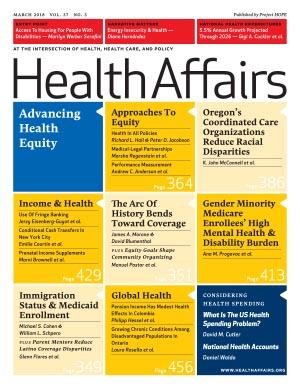Research published by the National Center for Medical-Legal Partnership (NCMLP) in Health Affairs shares how more than 300 hospitals, health centers, and clinics across the U.S. are using legal services to address patients’ unmet social needs. The article is part of the journal’s issue on advancing health equity, and highlights different approaches health care organizations take to implement medical-legal partnerships that place civil legal aid professionals into the health care setting to treat issues—including housing, access to insurance, and stable guardianship—that drive health inequities.
 The researchers drew on national survey findings and field research to identify multiple models for delivering legal services in clinical settings. They found that different health care organizations—from pediatric primary care clinics serving low-income neighborhoods, to health centers with highly specialized programs for complex, chronic conditions—adapt medical-legal partnership services to meet the specific needs of their patients.
The researchers drew on national survey findings and field research to identify multiple models for delivering legal services in clinical settings. They found that different health care organizations—from pediatric primary care clinics serving low-income neighborhoods, to health centers with highly specialized programs for complex, chronic conditions—adapt medical-legal partnership services to meet the specific needs of their patients.
“For years, pilot studies have shown the extreme promise of medical-legal partnership to address some of patients’ most seemingly intractable social problems,” said Marsha Regenstein, PhD, lead author and Director of Research for NCMLP. “What this research illustrates is that medical-legal partnership is a flexible intervention, and that health care is figuring out a variety of different ways to leverage it to best serve the needs of different patient populations.”
While the models of delivery vary, the paper’s authors identified eight core elements that define the medical-legal partnership intervention. These include the use of training to bridge clinicians understanding of when legal help is best deployed, and the presence of lawyers on-site in the clinical setting to help legal staff better understand the challenges patients face.
“These partnerships demonstrate the desire and ability of health care and legal professionals to work together with shared goals to advance health equity for vulnerable communities,” said Ellen Lawton, co-director of NCMLP. “And we’ve seen great strides to bring the intervention more mainstream through incredible leadership from both the Health Resources and Services Administration and the Veterans Health Administration, which support medical-legal partnership as a mechanism for advancing equity among the people they serve.”
Encouraging funding possibilities are emerging for such partnerships. For example, several states have recently launched pilots to incorporate legal services into Medicaid payment rates. However, the researchers conclude that in order to scale and spread this intervention properly, medical-legal partnerships need more sustainable funding. The authors also highlighted the need to better align this intervention with other social determinant of health clinical initiatives, and for practical guidance on how to target scarce medical-legal partnership resources.
The commentary, “Addressing Social Determinants of Health Through Medical-Legal Partnerships,” was written by Marsha Regenstein, Jennifer Trott, Alanna Williamson, and Joanna Theiss. Click here to read the article on Health Affairs’ website.
